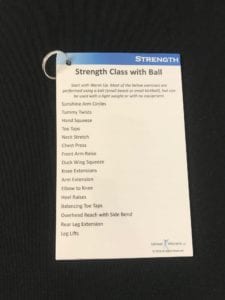Exercise is essential to keeping seniors healthy, active, and motivated. But getting them on board with a well-rounded exercise program can be a challenging task. Senior living providers are looking for fresh approaches to engage residents in fitness – with easy-to-implement group programs that still meet individual needs.
New Tools for Senior Living Providers
 The Quick Reference Exercise Guide, a tool developed by Lifetime Wellness, makes it easy for senior living providers to deliver an effective, person-centered exercise experience.
The Quick Reference Exercise Guide, a tool developed by Lifetime Wellness, makes it easy for senior living providers to deliver an effective, person-centered exercise experience.
Designed for a simple implementation, the Quick Reference Exercise Guide offers a varied and engaging fitness program that can be used in any senior setting, from assisted living to skilled nursing. “The program includes 12 different exercise guide cards that are fun and beneficial, from warm-up activities to cardiovascular exercises and balance training,” says Robin Gill, Regional Wellness Director at Lifetime Wellness. “It works great in a group setting and is particularly helpful for staff who may not have a background in exercise. It’s also well suited for individual and one-on-one use.”
The guide’s 5.5 x 8.5 laminated cards link onto a keyring for quick access. “If residents lose interest in one set of exercises, the exercise instructor can flip to a new card, try another routine, and reengage the group,” Gill says.
Reinforcing Four Types of Exercise
For optimum senior health and well-being, the National Institutes of Health (NIH) recommends four types of exercise: strength, balance, flexibility, and endurance.
The Quick Reference Exercise Guide includes activities in all four areas:
 Strength – Strength-building exercises, such as resistance training using elastic bands and free weights, improve muscle tone and can reduce age-related muscle loss. Exercises range from arm raises and knee flexes to chair stands and bicep curls. “These activities retain and build muscles and increase metabolism,” Gill says. “They can also help maintain independence and keep blood sugar stable.”
Strength – Strength-building exercises, such as resistance training using elastic bands and free weights, improve muscle tone and can reduce age-related muscle loss. Exercises range from arm raises and knee flexes to chair stands and bicep curls. “These activities retain and build muscles and increase metabolism,” Gill says. “They can also help maintain independence and keep blood sugar stable.”- Balance – Falls can cause moderate to severe injuries, from disabling hip fractures to traumatic brain injuries. “Balance exercises help to prevent falls and avoid the serious problems that can follow a fall,” Gill says. “Regularly doing a few simple exercises, such as Tai Chi, can gradually improve balance, increase coordination, and lower fall risk.”
- Flexibility– Stretching is essential to staying nimble; It increases range of motion in the shoulders, spine, and hips. “As we age, muscles shorten and lose their elasticity,” Gill says. “Stretching can restore flexibility and freedom of movement.” A popular choice for seniors is yoga, combining gentle, stretching movements with deep breathing techniques. “Chair yoga exercises and relaxation practices can be done without getting on the floor – and are an excellent choice for those with mobility challenges.”
- Aerobic endurance – Endurance exercises help circulate more oxygen in the blood, helping to improve cardiovascular health and brain function. Activities include any continuous activities, such as walking or chair dancing, that elevate breathing and keep the heart rate up.

Realizing the Benefits
Studies have found that staying fit delivers a wide swath of physical and mental benefits – from lowering blood pressure and building stronger muscles to boosting mood, improving memory, and protecting the brain from age-related mental decline.
Group fitness activities have the added benefit of providing social connection. “Exercise has a strong psychological component,” Gill says. “It promotes community and reduces feelings of loneliness, which are experienced regularly by nearly half of all older adults. Such activities as our ‘Laugh Well’ program are specifically designed to connect people, heart to heart. Also, the Octaband – a 16-leg piece of stretchy nylon-spandex – is a playful way to increase interaction through group movement.”
Ultimately, a vibrant senior fitness program helps seniors maintain functional independence for as long as possible. Following the activities in the Quick Reference Exercise Guide, caretakers can help residents stay in shape, in motion, and in sync with opportunities for an enhanced quality of life.